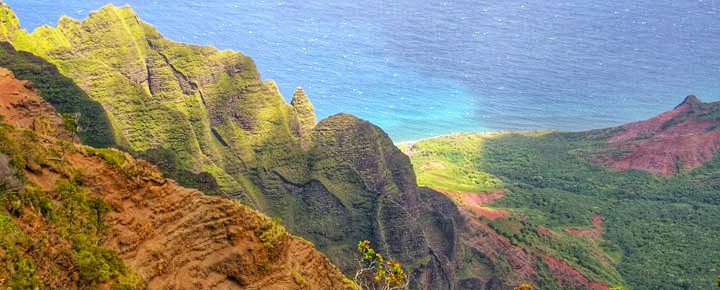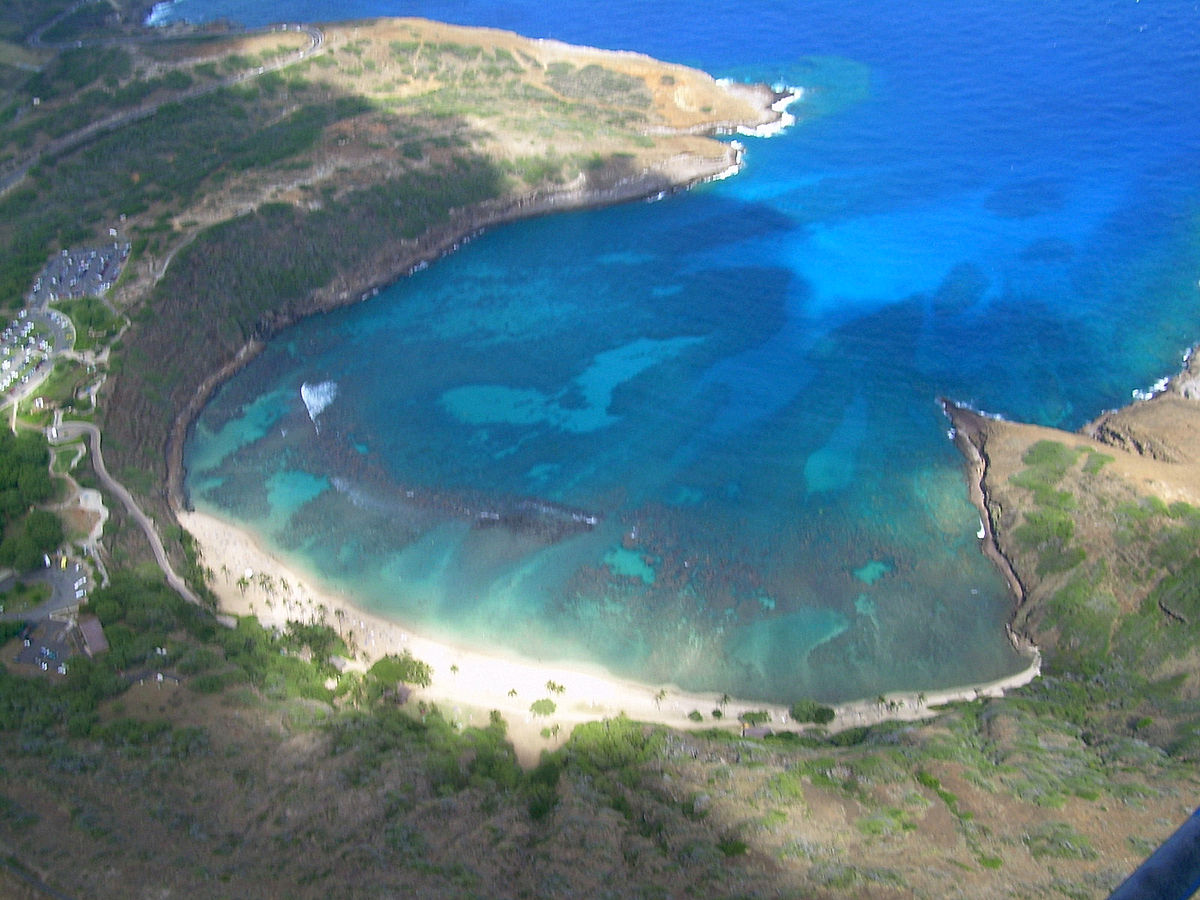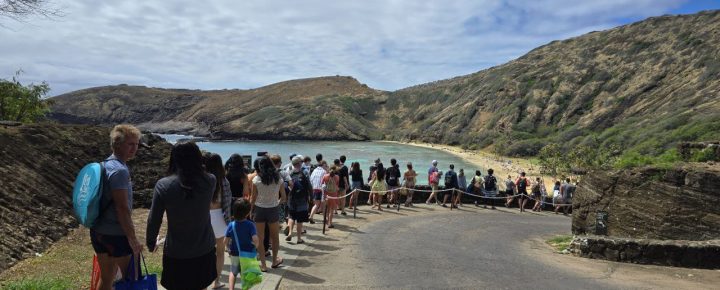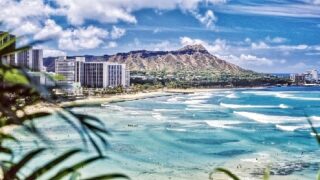The Hawaii legislature again declined to pass the latest proposed $25 green fee for arriving visitors. But don’t get excited quite yet. While that’s a disappointment to Governor Green and a projected loss of $68 million annually to finance projects related to climate and environment, it’s far from over.
This is now the third time legislators have decided against implementing the fee that has been the hallmark proposal of the governor since he ran for office. The Hawaii House of Representatives initially approved it. In the Senate chamber, however, the concept failed to achieve traction and failed. This is a slap in the face of Josh Green, who made this measure among his top legislative priorities.
This leaves Hawaii’s environmental initiatives unfunded following the devastating 2023 wildfires that destroyed Lahaina.


The proposed $25 fee was to have been levied on all visitors.
How that would have been implemented, however, never became clear. An alternative option was to raise the 18% Hawaii accommodation tax even further.
There was local opposition, including from Mufi Hannemann via his Hawaii Lodging and Tourism Association. You’ll recall that Mufi is also chair of the Hawaii Tourism Authority. The fear among tourism industry stakeholders remains that such a fee, both conceptually and financially, would deter Hawaii visitors and send them to other destination options.


New HB 2563 promotes app to collect fees at Hawaii beaches and parks.
Visitor fee-focused State Representative Sean Quinlan is now promoting House Bill 2563. You may recall that this would create a new mobile app to collect tourist fees at popular Hawaii beaches and hiking trails. It is believed, however, that this plan will not generate funds in proportion to those via the now-defunct green fee.
The app-based fees would be based on a registration system for “tourism hot spots” and more. Further support for this comes in response to the failure of the green fee and Hawaii’s ongoing challenges with tourism management.
Could a visitor app simplify and modernize the Hawaii visitor experience?
Of potential benefit, the app inspired by Disneyland, purports to provide real-time destination information while directing tourists to less crowded destinations. Many have commented, however, that even Disneyland doesn’t have a functional app.


Up to six locations in Hawaii may be selected for test implementation. On the plus side, visitors can make all their reservations in one app. Currently, if you want to visit Diamond Head, Hanauma Bay, or Kee Beach, you have to go to each site separately.
Improvement to disjointed Hawaii rules and regulations for visitors.
Hawaii visitors could purchase pre-paid time slots at popular destinations, thereby helping reduce congestion.


This would be similar to Oahu’s Hanauma Bay, which we recently experienced and wrote about. According to our reading of the bill, it would ultimately be statewide and might also include county facilities. The state wants to improve the visitor experience, minimize the negative tourism impact on Hawaii residents, and make a cohesive plan rather than a different way to make reservations at each location.
Another improvement would be accessibility. That includes accessible facilities and multi-lingual support.
The bill would park the responsibility for the app and the entire reservation system within the purview of the troubled Hawaii Tourism Authority. This Hawaii visit app proposal is favored by Mufi Hannemann’s entities, the Hawaii Tourism Authority, and the Hawaii Tourism and Lodging Association.
The big question is: How do you feel about this proposed change from green fee to the app?
Get Breaking Hawaii Travel News







How about increasing the tax % for all those corporations that make tons of money and then just send off all those gains/profits elsewhere except Hawai’i’s own and it’s nature. Also increase the non-resident tax for people that own property in HI but are not residents of the state, and finally also increase % of tax for residents that own more than one property, with the exception for the one they live in. When are politicians are going to decide what is ethically righteous and protect the environment of the islands, and the people that actually live in the state and make the community? Low-paying slave wages Do Not count as progress!
And how about increasing the tax to a local resident who sells their property to another non resident, the state should like that..the get big $$$ on both ends.
Also if you are worried about us tourists ruining the beaches, state parks etc why don’t you pay us tourists $25, or another incentive, to Not visit those places. I/we do not need/care to visit those places anyway to have an awesome time.
BOH,
Why do some posts not have aa Reply button?
Mahalo,
Rod
Hi Rod.
Thanks for asking! We’ll check on that as it shouldn’t be the case.
Aloha.
Thank you. I wanted to reply to Deaan but was unable to do so.
Happy Easter.
Rod
This state survives off tourism.
We need to appreciate and encourage tourism, not over tax and run them off to other locations. We saw the impact of lost revenue from Covid and the fires, bring tourism back to Maui to generate revenue, not by adding more fees and pushing them to other destinations.
I don’t take my mobile phone to the beach (fear of theft while I’m swimming). How to prove I paid the proposed “Visitor License Fee” (VLF)? A paper pass would just get rumpled and disintegrate in my shorts pocket. Also how to prove that a physical VLF was legitimate and purchased from a legitimate source?
HB 2563 Proposes a $50 annual VLF.
Increase wages via a statewide higher minimum wage. This will increase residents’ ability to survive with the high cost of living in Hawaii. At the same time it increases Hawaii tax revenues without the negative perception of fees. Quit attacking local small businesses as those actions benefit out of state, large corporations. S.T.R. Employ people too, doing cleaning, yard & pool maintenance, repairs. I don’t own any S.T.R. either!
Dean,
I know the impulse is to increase the minimum wage. But that is in conflict with what you wrote: “Quit attacking local small businesses…” Small businesses will pay those higher wages. The other thing, however, is if all lower-paid workers get a raise, the costs they pay for basics and extras will increase. And those making more will expect to maintain the spread between their wage and the new, higher minimum wage. Nothing much will change as to affordability.
If the Gov wants to do something meaningful – he should find savings in govt spending
But RodW, What your missing is that the small business should just cost on to the consumer. If everyone has the same financial impact, prices should go up in a uniform manner. The widget will increase in price accordingly. So while the small business will have higher costs, the higher costs can and should be passed on. So there should be no impact to the small business, other than those who elect to not buy the widget.
When you increase the price of something, you sell less of it. Small businesses in Hawaii are not making anything, other than food and odds and ends like cheap spear fishing gear. For the most part, they do not sell essentials, and even if they did, they are competing with the Costcos, Walmarts and Amazons of the world. (Fun fact, one of, if not the busiest, Costcos nationwide is in Honolulu). Look at what is happening in California with the fast food worker minimum wage. Less people employed, less businesses will exist, less new ones will open, and prices going up.
Rod & David, there are essentials and non-essentials, CA’s Fast Food (FF) mess demonstrates FF is not essential, that demand shifted elsewhere, perhaps less costly home kitchens. By raising the wages, Govt. has more tax $ to spend on needs, some support residents only (social services, retraining away from tourist jobs) others benefit tourists as well (infrastructures). Sales of non-essentials will shrink; but remain roughly stable for essentials. Workers displaced from non-essentials businesses will transition to new positions supporting essentials, maybe gaining new skills. Eventually, non-essential and essential businesses will achieve a new equilibrium. Supply and demand, will increase the price of non-essentials.
Also, my small business comment was not worded well towards ending protectionism of big lodging companies.
Dean,
I fully understand that. But how does that help the people of small businesses? If my rent and groceries and gas go up 5% and my wages go up a similar amount how am I better off?
Hawai’i politicians can help the local workers today by eliminating the income tax. This is one of the reasons why millions of locals have move to Nevada and other states. Lower cost of living benefit local everyday workers, who are struggling to survive on the islands. But since they’re never do that, Hawai’i will continue to become the playland of the rich and connected, and the brain drain will get worse.
There seems to be an increasing hostility toward visitors by Gov. Green. We visitors (us for 30 years for example) feel less welcome and therefore less willing to support your economy. Your taxes on accommodations are unreasonable. Maui is also taking on the character of a large city. Crime is increasing. Local traffic largely ignores traffic rules and the police turn a blind eye. Alanui Drive has become unsafe due to speeding locals yet I have never seen law enforcement along this route. Noise ordinances are not enforced. I could go on.
Millennial here… if I need technology to go to the beach, I’d rather be dead. Many of us are so tired with needing smart phones and apps for literally everything. I understand that certain hotspots are crowded. Am I the only one who thinks… so what? It’s crowded. That’s part of life. It never bothers me to see other people enjoying something majestic and beautiful; the more the merrier, just don’t be disrespectful.
I’m not vehemently against reservations; Yosemite has been doing that for years. But they also have first come first serve slots available, year round.
The $25 fee is looking attractive now that an app is the alternative.
Green’s “Green Fee” was doable. For a week’s stay that comes to about $3.50-a-day per person. Easy for Hawaii tourists. The app I like better, it’s pay-as-you-go. The Disneyland app is fully functional, it’s just not 100% accurate. But it’s good enough that everyone uses it. I would use the Hawaii app to pay to “reserve” a time. If you are more spontaneous you could check last minute openings at less congested parks. It’s great for people with means!! Two big downsides: 1. Locals don’t always have the $$ tourists do. 2. HTA…(enuf said)
If paying a $25fee means that I don’t have to pay for parking at beaches or other add on fees that really add up over our usual 2 week stay I can live with that. I just don’t see that the money will really go to the proposed use. Governments have a history of a lot of waste, fraud, and abuse. I have not heard of any plans to mitigate that.
Also, If the fee is $25.00 this year it will be $40.00 next year. If you give them an inch they will take a mile. Regardless of whether or not the money will be used for the intended purpose.
I’d be happy to pay $25 per person to get into Hawaii. Honestly, what’s another $100 for a family of 4 when you’re already spending a small fortune for your trip? Anything that can help Hawaii and more specifically Maui find a visitor balance and truly welcome us back is a step forward. As a visitor who was on Maui during the fires I have very mixed feelings about returning to a place I loved.
Come on. Read the United States Constitution. “Get into” a state? Article IV, Section 2, prevents one state from discriminating against the citizens of another state. This includes the *fundamental* right of travel, or to freely travel about the states.
Shocking you have no problem “paying” to enter a state, when the Privileges and Immunities Clause prohibits this.
I say the Hawaii government just needs to continue on the self-destructive path they are currently on and they won’t have to worry about that $25 fee or an App because they will soon get what they say they want…less visitors. Perhaps they should be thinking long term about how they are going to run the state when the tourists stop coming and locals flee because they can no longer afford to live in “paradise”.
Hi Sheryl,
Californian here. I would say that it sure seems like that is what the government of Hawaii wants… for people to flee, so only the rich and powerful can remain. The same has been happening in CA since Newsom took over.
What to do if you don’t have a “smart” phone (and never will) and can’t use the “app”…
Asking for a friend…
Hi Jay.
We’ve heard there will be an alternate provision.
Aloha.
97% of people have a cell phone. 90% own a smart phone. And around my parts, if you can’t afford one, the government will practically buy one for you.
Yani V.
If they keep on increasing fees and taxes, I would rather take my family to other destinations. There’s Mexico, the Caribbean, Canada, and Europe. We’re quite aware of what happened in Lahaina and we’ve contributed a lot. They don’t have to punish us visitors. We’re trying to help their tourism industry by going there but don’t make it such a hurdle.
I’d rather pay a upfront fee and not be bothered by a phone app or reserving a place on the beach. I don’t frequent the big tourism locations anymore except perhaps Kokee State Park. We know our way around smaller less popular but beautiful beaches and we spend just a little bit of time at any specific location. What I don’t usually do is plan what I’m doing each day on a vacation – we head out and plan it along the way each day.
Erika,
I’m with you! We used to rent a car for the entire trip. Now, we take the bus to Walmart and Costco. And, when we feel like heading out to, say, the North Shore, we rent a car for the day. So, we return the car before closing time and don’t have to deal with hotel parking fees.
RW;
Like the way you think. I do similar types of “work-arounds” on Maui to keep the hassles and costs under control.
If people are concerned about crowding at popular sites I have a better idea than an app. How about just get out of bed early and go. Before 9 AM it’s almost never crowded, pretty much anywhere. After 10 AM, forget it.
Hi Mike,
Not only that but if you enjoy photography, early morning shots are unique. That’s hard for me because I tend to stay up late – 1 or 2 am. So, getting up at 6 is hard. But sometimes you have to go for the shot.
But, car rentals are crazy when you figure $30, $40, $50 a day for parking. I think most of us are done by 6 or 7pm, so returning a rental should be a no-brainer in many cases.
What state are you from? I live in SoCal.
We are usually staying in a private rental home on the North Shore, not a resort, so a car is essential, as busses are few and far between. There are no parking costs when you rent a home and we don’t mind cooking on vacation. We usually take one or two longer trips to Kokee State Park for a long day. There seems to be a new bus/shuttle system on the North Shore beaches starting in Hanalei out to the end and back. We have not used it yet but wondering how well that works out.
The shuttle from Waipa parking lot to Ke’e is $40 per person (less for kids). And requires reservations. It’s not worth it just to go to Ke’e, but – unless you get on-line at midnight HI time exactly 30 days in advance – it’s the only way you can access the Kalalau trailhead to hike to Hanakapi’ai beach/falls, which is a popular hike gohaena.com/info-faqs/
As a regular visitor of Kaua’i & a former (temporary) resident of O’ahu, I would be happy to pay a green fee. Tourists are causing the greatest environmental impact & if we want to keep the lure of Hawaii- lush, preserved habitat for tropical vegetation & wildlife, then we should open our wallets & pay to protect it.
My personal feelings regarding an app are mixed. The negatives are connectivity. Cell service isn’t always available at secluded (and not) locations.
Secondly, it excludes some of the older generation who aren’t tech savvy & those wanting to disconnect. It may be a hassle for those using & structuring the service.
Positive-I would love to have a scheduled time w/ limited “company” at a popular site.
Julie,
“Tourists are causing the greatest environmental impact…” Fact or opinion?
First visit to Hawaii was in 1965. Been there many times since – my family never abuses the land, never.
Well, considering there are about seven times more tourists annually, than there are year-round residents, it’s logic and math.
Positive or negative impact from tourists… it could be argued that if tax dollars generated from tourists were used appropriately, it is a positive impact on Hawaii and the infrastructure.
Some of the tax dollars could be allocated to clean up junk cars, couchs, etc. that some locals leave alongside the roads and in wilderness areas too.
My biggest concern with apps to reserve a time slot is that when I tried such systems in the past, they always seemed full, or you have to make reservations a few days prior. I don’t always know where and when I will head to a location. OK for larger beaches or state parks but not for others.
Tourism will continue to crater. Just looked at booking a higher-end Maui hotel from December 19 through the 30th, basically an eleven-night stay during high season. The prices were shocking. The taxes even more shocking.
For a Non-oceanfront “garden-facing” room, you’re looking at anywhere from $900 to $1500 per night, so base cost was over $16,500. Oh, but the taxes and fees: Hawaii State Occupancy Tax, $1,720; Maui County Occupancy Tax, $503; Hawaii Sales Tax, $791; Resort Fee, $566. Taxes and fees = $3,580. Grand Total: just under $20,400.
This is why people stay in condos, airbnbs, and short-term rentals, and are opposed to even more taxes.
Hawaii is not setting hotel prices. The hotels are. That $900 to $1500 per night and goes straight to the corporate headquarters somewhere on the mainland, along with the resort fees.
Since the taxes are percentages, not fixed dollar amounts, those come down when room rates come down. Your beef is with the hotel companies.
From everything I have been reading lately, and for quite a while, I am glad we visited many times pre COVID when things were much easier and quieter. We would rent a condo on Kauai for a month and just relax and go hiking and walking and just blend in.
Surely most of you know that the attempts by the Greedy Politicians to gain more of you visitors monies Is Not Going To Stop! You Stop It by visiting somewhere else and spending your money where is is Appreciated.
Perhaps it would be more fair to increase income tax on residents. Or also increase the gasoline tax, which is half of the $0.35 California rate. Best of all, find better efficiencies in current programs – there must be at least $68 million there alone.
A $68,000,000 shortfall could be made up by about $50 per person per year (before considering additional business taxes).
Dear Hawaii Government,
My family is from Maui and my Grandparents still live on the island. I own a condo on the island as well. I just returned from a 2 week visit and I can assure you that many visitors are getting tired of how expensive hotels and rentals are on the the island. I always talk to people visiting and that was there number one complaint. Most are long time visitors who have been coming for years. 1 couple told me this is probably there last visit and will be going to Mexico from now on due to costs. I understand the impact of the fires on the locals & such, but we need tourists and the costs are extreme right now with the hotel/visitor tax for hotels and condo’s. Once tourists decide to leave, they will never come back
Well said Patrick G.
Unfortunately the one party special interest incompetent government of Hawaii isn’t listening and doesn’t really care what the average citizen thinks. They’re more concerned with promoting their misguided political agenda and consolidating power!
Daryl H, I couldn’t agree more. It seems like governor Green just doesn’t care about tourists to Maui. That is a need and will only help rebuild Lahaina and provide support.